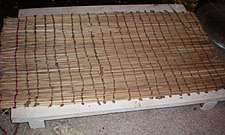Desmostachya bipinnata
Desmostachya bipinnata, commonly known in English by the names halfa grass, big cordgrass, and salt reed-grass,[3] is an Old World perennial grass, long known and used in human history.
| Desmostachya bipinnata | |
|---|---|
_(9301605394).jpg) | |
| Desmostachya bipinnata (right plant) | |
| Scientific classification | |
| Kingdom: | Plantae |
| Clade: | Tracheophytes |
| Clade: | Angiosperms |
| Clade: | Monocots |
| Clade: | Commelinids |
| Order: | Poales |
| Family: | Poaceae |
| Genus: | Desmostachya |
| Species: | D. bipinnata |
| Binomial name | |
| Desmostachya bipinnata | |
| Synonyms[2] | |
| |
Distribution
Desmostachya bipinnata is native to northeast and west tropical, and northern Africa (in Algeria, Chad, Egypt, Eritrea, Ethiopia, Libya, Mauritania, Somalia, Sudan, Tunisia); and countries in the Middle East, and temperate and tropical Asia (in Afghanistan, China, India, Iran, Iraq, Israel, Myanmar, Nepal, Pakistan, Saudi Arabia, Thailand).[4]
Uses
Medicinal
In folk medicine, Desmostachya bipinnata has been used variously to treat dysentery and menorrhagia, and as a diuretic.[5]
Religious
Desmostachya bipinnata has long been used in various traditions (Hindus, Jains and Buddhists) as a very sacred plant. According to early Buddhist accounts, it was the material used by Buddha for his meditation seat when he attained enlightenment.[6] The plant was mentioned in the Rig Veda for use in sacred ceremonies and also as a seat for priests and the gods.[7] Kusha grass is specifically recommended by Lord Krishna in the Bhagavad Gita as part of the ideal seat for meditation.[8]
Notes
- Lansdown, R.V. (2013). "Desmostachya bipinnata". IUCN Red List of Threatened Species. 2013: e.T13579796A13596921. Retrieved 27 May 2020.
- "Desmostachya bipinnata". Plants of the World Online. Royal Botanic Gardens, Kew. Retrieved 27 May 2020.
- Martha Modzelevich. "Desmostachya bipinnata". Flowers in Israel. Retrieved June 15, 2011.
- "Desmostachya bipinnata". Germplasm Resources Information Network (GRIN). Agricultural Research Service (ARS), United States Department of Agriculture (USDA). Retrieved June 15, 2011.
- James A. Duke. "Desmostachya bipinnata (POACEAE)". Green Farmacy Garden, Fulton, Maryland: Dr. Duke's Phytochemical and Ethnobotanical Databases. Retrieved June 15, 2011.
- Professor Paul Williams (2006). Buddhism: Critical Concepts in Religious Studies (Critical Concepts in Religious Studies S.). New York: Routledge. p. 262. ISBN 0-415-33226-5.
- Griffith, Ralph T. H. (1896). The Hymns of the Rigveda, Volume 1. p. 4.
- "Establishing a firm seat for himself, In a clean place, Not too high, Not too low, covered with cloth, and antelope skin, and kusha grass" (B.G. VI:11) Smith, Huston; Chapple, Christopher; Sargeant, Winthrop (2009). The Bhagavad Gita (Excelsior Editions). Excelsior Editions/State University of New Yo. p. 282. ISBN 1-4384-2842-1.
- Ahmad, R.; Shaikh, A.S. (January–June 2003). "Common Weeds of Wheat and Their Control" (PDF). Pakistan Journal of Water Resources. 7 (1): 73–76. Retrieved June 15, 2011.
| Wikimedia Commons has media related to Desmostachya bipinnata. |
Further reading
- Mahdihassan, S. (1987). "Three Important Vedic Grasses" (PDF). Indian Journal of History of Science. 22 (4): 286–291. Archived from the original (PDF) on March 14, 2012. Retrieved February 7, 2011.

